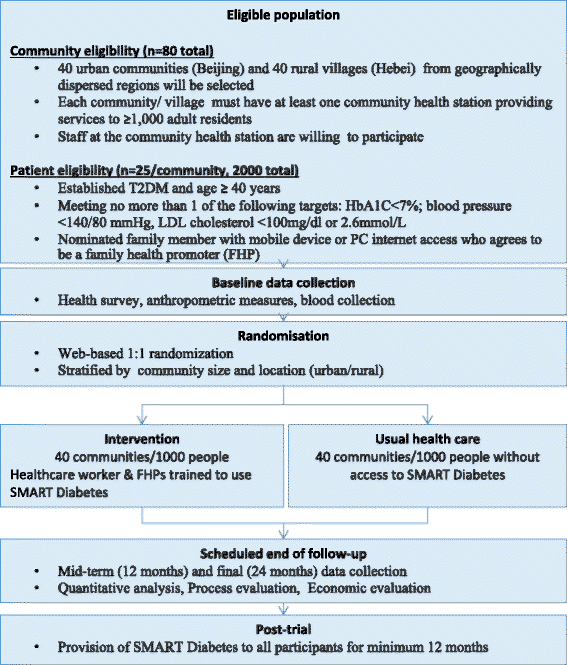Systematic medical assessment, referral and treatment for diabetes care in China using lay family health promoters: protocol for the SMARTDiabetes cluster randomised controlled trial
- PMID: 27535128
- PMCID: PMC4989287
- DOI: 10.1186/s13012-016-0481-8
Systematic medical assessment, referral and treatment for diabetes care in China using lay family health promoters: protocol for the SMARTDiabetes cluster randomised controlled trial
Abstract
Background: Type 2 diabetes (T2DM) affects 113.9 million people in China, the largest number of any country in the world (JAMA 310:948-59, 2013). T2DM prevalence has risen dramatically from around 1 % in the 1980s to now over 10 % and is expected to continue rising. Despite the growing disease burden, few people with T2DM are achieving adequate management targets to prevent complications. Health system infrastructure in China is struggling to meet these gaps in care, and innovative, cost-effective and affordable solutions are needed. One promising strategy that may be particularly relevant to the Chinese context is improving support for lay family members to care for their relatives with T2DM.
Methods: We hypothesise that an interactive mobile health management system can support lay family health promoters (FHP) and healthcare staff to improve clinical outcomes for family members with T2DM through medical assessment, regular monitoring, lifestyle advice and the prescribing of guidelines recommended medications. This intervention will be implemented as a cluster randomised controlled trial involving 80 communities (40 communities in Beijing and 40 rural villages in Hebei province) and 2000 people with T2DM. Outcome analyses will be conducted blinded to intervention allocation. The primary outcome is the proportion of patients achieving ≥2 "ABC" goals (HbA1c <7.0 %, blood pressure (BP) <140/80 mmHg and LDL cholesterol <100 mg/dl or 2.6 mmol/L) at the end of follow-up (Diabetes Care 36(Supplement 1):S11-S66, 2013). Secondary outcomes include the proportion of patients achieving individual ABC targets; mean changes in HbA1c, BP, LDL, renal function (serum creatinine and urinary albumin), body mass index, quality of life (QOL, EQ-5D), and healthcare utilisation from baseline; and cost-effectiveness/utility of intervention. Trial outcomes will be accompanied by detailed process and economic evaluations.
Discussion: The Chinese government has prioritised prevention and treatment of diabetes as 1 of 11 National Basic Public Health Services. Despite great promise for mHealth interventions to improve access to effective health care, there remains uncertainty about how this can be successfully achieved. The findings are likely to inform policy on a scalable strategy to overcome sub-optimal access to effective health care in China.
Trial registration: Clinicaltrials.gov NCT02726100.
Keywords: Capacity strengthening; China; Implementation; Type 2 diabetes; mHealth.
Figures
References
-
- Yang W, Lu J, Weng J, Jia W, Ji L, Xiao J, Shan Z, Liu J, Tian H, Ji Q, Zhu D, Ge J, Lin L, Chen L, Guo X, Zhao Z, Li Q, Zhou Z, Shan G, He J, China National Diabetes and Metabolic Disorders Study Group Prevalence of diabetes among men and women in China. N Engl J Med. 2010;362(12):1090–101. doi: 10.1056/NEJMoa0908292. - DOI - PubMed
-
- Xu Y, Wang L, He J, Bi Y, Li M, Wang T, Wang L, Jiang Y, Dai M, Lu J, Xu M, Li Y, Hu N, Li J, Mi S, Chen CS, Li G, Mu Y, Zhao J, Kong L, Chen J, Lai S, Wang W, Zhao W, Ning G, 2010 China Noncommunicable Disease Surveillance Group Prevalence and control of diabetes in Chinese adults. JAMA. 2013;310(9):948–59. doi: 10.1001/jama.2013.168118. - DOI - PubMed
-
- Zheng LL, Li CY, Chang FS, Lu YL, He XJ, Ma JQ, et al. Slow progress in the prevention and control of chronic diseases—utility 9 of performance assessment for provincial centers for disease control and prevention. Chin Health Resour. 2012;02:92–4.
-
- Chinese Ministry of Health. Family Health Care Survey 2008 [Available from: http://www.moh.gov.cn/cmsresources/mohwsbwstjxxzx/cmsrsdocument/doc9913.pdf. Accessed 10 Aug 2016.
Publication types
MeSH terms
Associated data
LinkOut - more resources
Full Text Sources
Other Literature Sources
Medical



